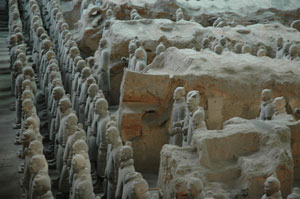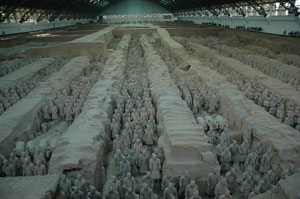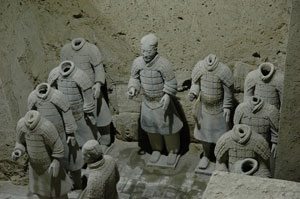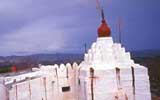|
|
Travel > China > Time for Terracotta
Copyright © 2007 Ted P. Eugenis
Time for Terracotta
Posted 24 October 2006
Due to my inability to speak Chinese, and an unclear policy on Tibet travel permits and train travel to Lhasa, we spent $300 on train tickets and lodging to visit Xi'an, the ancient capital of China and home of the Qin dynasty's terracotta warriors. I am very excited to see these warriors after reading about them, looking at photos, and watching TV specials.

|
|
A semi-excavated pit of terracotta warriors.
|
Xi'an is a city of three million people. Its train station is not as modern as the Bejing West station, but it has many of the electronic sign boards and PA system Beijng has. That is all we know about modern Xi'an. We have no map, nor guidebook or lodging arranged. But we must have a sign in Mandarin that says, "Touts, please annoy us...now." It seems like everytime we get off a bus or train, a smiling, friendly gal promises us great hotel prices, tours at rock-bottom cost, translation services, almost everything but the Chinese basket trick, which I'm sure could be arranged if we asked for it.

|
|
Side view of the front of the large pit.
|
Xi'an is no different. After we purchase tickets for our return to Beijing, a gregarious tout convinces us to check out a new, modern, nice hotel. The ride in the hotel van is free and there is a a caveat, "You look. If no like, no take, okay?" Okay, we say, okay. At least will get to town, we have no yuan after buying our tickets back to Beijing and need to change dollars on Sunday - not an easy task.
We soon arrive at yet another Chinese architectural abortion. It is "modern and nice" like mini skirt on a pudgy teenage girl - not attractive but functional.
Maria checks out the room and says that we should check in. This is our standard protocol for traveling: if she likes the room, we take it. Given my extreme disdain for youth hostels, not to mention I am middle aged and no longer a youth, and we have no idea of other hotels, we opt for the tout's hotel, actually a good deal at 220 yuan even though I saw a few roaches in the closet and our table mate at breakfast plucked one out of her bean curd.
Our room has a 27" TV, an the usual mini-bar with pop, water, chips and some other snacks. In another basket, other items are for sale. A condom, some lotion which includes the instructions to "rub on the man's genitals for 2-3 minutes to promote energy and exitement." Another package contains contents "Made in the USA but processed in China." The text on the label also claims the lotion will kill the HIV virus. I also find two pairs of men's underwear, a terrycloth towel, and what appears to be a non-woven mitten. Maria ignores me when I ask her to try on the underwear. We decide to venture out and find the soldiers.

|
|
The pit is almost 230 meters long.
|
After inquiring at the local youth hostel, we board a city bus that will take us to another bus that will drop of us off at the terracotta pits. Round trip will cost us 32 yuan, or 300 yuan cheaper than locally arranged tour.
We meet a couple from New Zealand on the bus and I tell them a story about a German kid who made an outfit similar to the warriors, jumped in the pit and posed as a warrior before security hauled him out. Accounts vary as to the duration of his visit to the warrior pit, but his disguise was good enough to elude officials until an alert security officer noticed him.
It takes us almost 5 minutes to find the entrance - this is no simple pit with a sign that says, 'Do not enter the excavation site.' It is a large park like complex with restauransts, gift shops and what appear to be offices. There are also museum-like buildings and three large buildings where the warriors are. Two of the pits are under excavation, while the third and most famous pit houses the legion of archers, horsemen and chariots.
Some speculate that Qin Shi Huang, the Emperor in 221 BC, had one million workers build the terracotta army to "create an illusion of strength and manpower." He may have believed that as "enemies approached, they would be overwhelmed with the powerful army supporting Emperor Qin and turn away."

|
|
Headless warriors.
|
As I gaze upon the warriors and absorb some of these facts, I wonder if the Emperor considered that maybe a few of the workers may have sold this information to would-be invaders? That his grand illusion could be be revealed with one well thrown rock that would have shattered one of the warriors?
I guess that those questions of mine will never be answered. But I sure would like to find that German kid, see the outfit he made, and ask him if he finds it ironic that he evaded security that is supposed to be protecting warriors.
|





